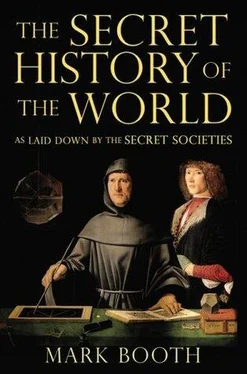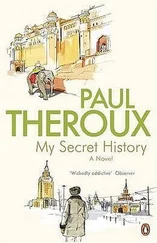Exodus chapter fourteen contains three verses — 19, 20 and 21 — which each consist of 72 letters. If you write these verses on top of one another so that the 72 letters appear in columns, then reading a column at a time, you will discover the secret 72 Names of God.
Each Hebrew letter is also a number. Aleph, the Hebrew A, is one, Beth is two and so on. There are complex connections here. The Hebrew word for father has a numerical value of 3 and the word for mother has a value of 41. The Hebrew word for child is 44, the combination of Father and Mother.
It gets more mind-blowing.
The numerical value of the Hebrew phrase for the Garden of Eden is 144. The numerical value of the Tree of Knowledge is 233. If you divide 233 by 144, you get very close — to four decimal points — to the value to the golden ratio phi!
In the last few decades mathematicians have applied themselves to the task of finding messages encoded in the text of the books of Moses. Breakthrough work by Witztum, Rips and Rosenberg aimed at discovering transcription codes using equidistant letter sequences. The published results include some names of post-biblical historical figures from Hebrew history, but as yet no propositions, no sequences of sentences or anything that could be read as a message. Again, it is not my secret to reveal, but one Cambridge-based statistician has shown me the results of applying an extremely complex ‘skip code’, a code verified as valid by a Cambridge University professor of mathematics. The fragments he showed me were reminiscent of the Psalms.
Imagine if a whole other book — or series of books — were encoded in the text we have! Would each of these texts have different layers of meaning too?
Such an achievement is beyond the capacity of normal human intelligence.
Recent research by an occult group has shown that J.S. Bach composed some of the world’s most beautiful melodies — such as the famous Chaconne — while at the same time giving each note the value of a letter of the alphabet. Bach’s music spells out secret, Psalm-like messages. This again is surely something beyond normal human intelligence?
In esoteric circles language which is imbued by initiates with layers of meaning is sometimes called the Green Language or Language of the Birds. Rabelais and Nostradamus, contemporaries at Montpellier University, as well as Shakespeare, are all said to have written it. Wagner refers to it when he alludes to the tradition that Siegfried learned the Language of the Birds by drinking dragon’s blood.
One last possibility while we are still on this topic. Perhaps we all speak the Green Language all the time? Perhaps the only difference between us and great initiates like Shakespeare is that they do it consciously?
SIGMUND FREUD WAS DEEPLY INTERESTED in the Cabala. As we will see, it was a formative influence on his thought. But he got hold of the wrong end of the stick when he argued that the Egyptian pharaoh Akhenaten was the source of Moses’s monotheism. We now know Moses came first. Akhenaten’s ideas of monotheism were subtly but dangerously different.
At the height of the Egyptian New Kingdom, the reign of Akhentaten’s father, Amenhotep III, seemed to signal a new era of even greater peace and prosperity which, even if didn’t match the unique achievement of the Great Pyramid, would see the construction of the most magnificent temples of the ancient world.
After the birth of three daughters Queen Tiy gave Amenhotep a son. Perhaps because he had been long awaited, perhaps partly because it was clear his father did not have long to live, the boy who was to become Akhenaten was brought up inside the temple precincts and grew up with a sense of cosmic mission.
Akhenaten had been born with a chromosomal defect that gave him a strange, hermaphroditic, even unearthly appearance: womanly thighs and an elongated face that might be read as ethereal, even spiritual. This defect can also lead to symptoms of mental instability — mania, delusions, paranoia.
Some combination of these factors may have contributed to his actions, which threatened to disrupt the whole progress of human evolution.
Unlike in Babylon, where kings acted independently of the priesthood, leading to extremes of despotic cruelty, the pharaohs of Egypt ruled under the aegis of the initiate priests. This is why the popular view of Akhenaten’s revolution that sees it as an act of radical individualism is quite wrong.
The start of Akhenaten’s reign coincided with the beginning of a Sothic cycle. This was one of the greatest of the astronomical cycles that shaped history, according to the priestly theology.
The Sothic cycle is 1460 years long. In Egyptian mythology each new beginning of this cycle saw the return of the Bennu bird, the Phoenix heralding the birth of the new age and a new dispensation. When Akhenaten announced the closing of the most magnificent temple in the world at Karnak, and the founding of a new cult centre and capital city approximately halfway between Karnak and Giza, this was not the wilful act of an eccentric individual, but an initiate king acting out cosmic destiny. He was preparing to welcome the return of the Bennu bird in 1321 BC.
His first act was to build a new temple to Aten, the god of the sun disc. In the great courtyard of Akhenaten’s new temple was its centrepiece, an obelisk topped by the Benben stone on which the legendary Phoenix was to alight.
His next act, supported by his mother Queen Tiy, was to build his great new capital city and sail the whole machinery of government down to it on barges. He wanted to shift the earth on its axis.
He then declared that all other gods did not really exist and that Aten was the one, true and only God. This was monotheism in something very like the modern sense. The worship of Isis, Osiris, and Amon-Re was forbidden. Their temples were effaced and shut down, and their popular festivals declared superstitions.
There is something appealing to modern sensibility about Akhenaten’s reforms. Like today’s monotheism, Akhenaten’s was materialistic. By definition monotheism does away with other gods — and it tends to do away with other spirits and other forms of disembodied intelligence too. So monotheism tends to be materialistic in the sense that it tends to deny the experience of spirits — and that experience, as we have already said, is what spirituality really is.
So it was the physical sun that Akhenaten declared divine and the source of all goodness. As a result, the art of Akhenaten’s reign did away with the hieratic formalism of traditional Egyptian art with its ranks of deities. Akhenaten’s art seems naturalistic in a way we find easy to appreciate. Some of his beautiful hymns to Aten have survived and they seem, remarkably, to anticipate the Psalms of David. ‘How manifold is that which you have made. You created the world according to your desire — all men, cattle and wild animals,’ declaimed Akhenaten. ‘How countless are your works,’ sang David, ‘you made all of them so wisely. The world is full of your creatures.’
But behind the poetry, behind all the clean intelligence and modernism there lurked a monomaniacal madness. By banning all the other gods and declaring himself the only channel for the wisdom and influence of Aten on earth, he was in effect making the whole priesthood redundant and replacing them with just himself.
But despite making himself the focus of all religious practice, he withdrew deeper and deeper into the maze of courtyards of his palace with his beautiful wife Nefertiti and their beloved children. He played with his young family, composed hymns and refused to hear any bad news regarding unrest among the people or of the rebellions in Egypt’s colonies that threatened its supremacy in the region.
Читать дальше












